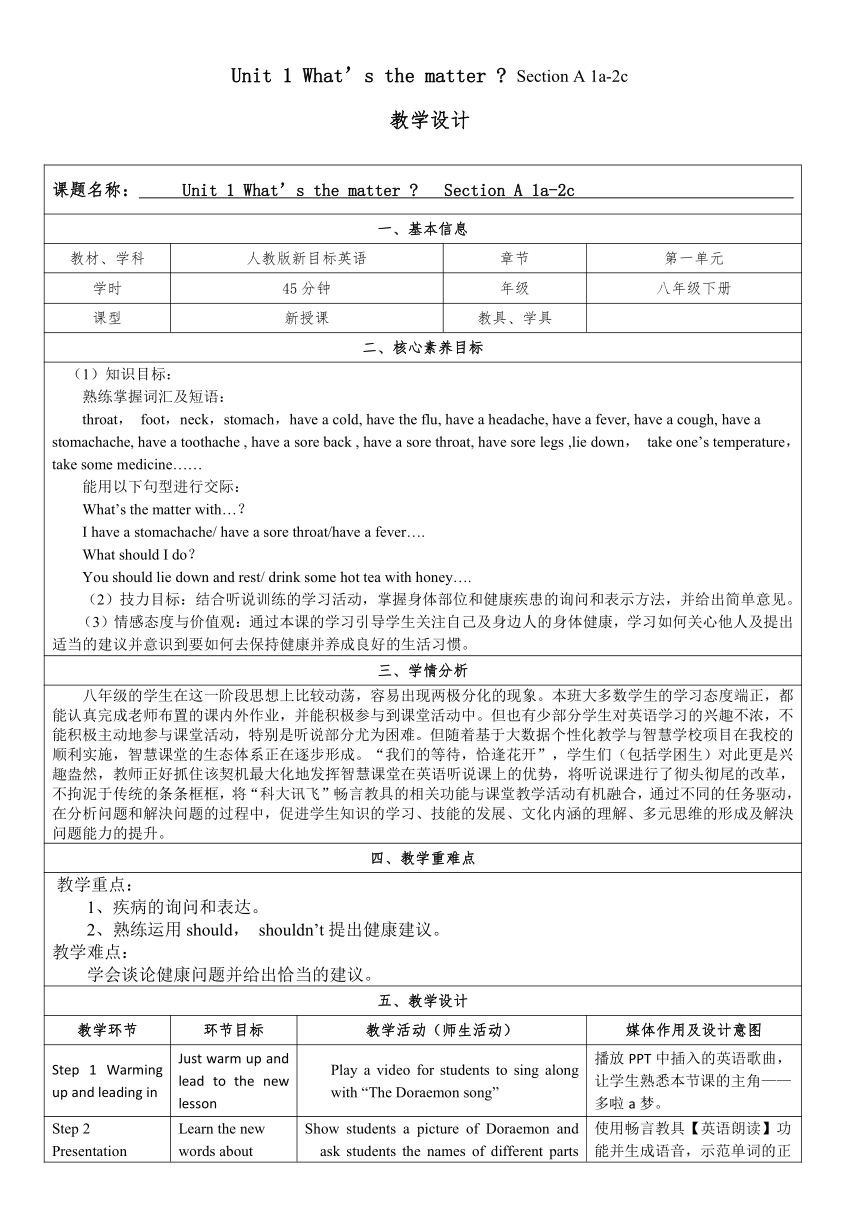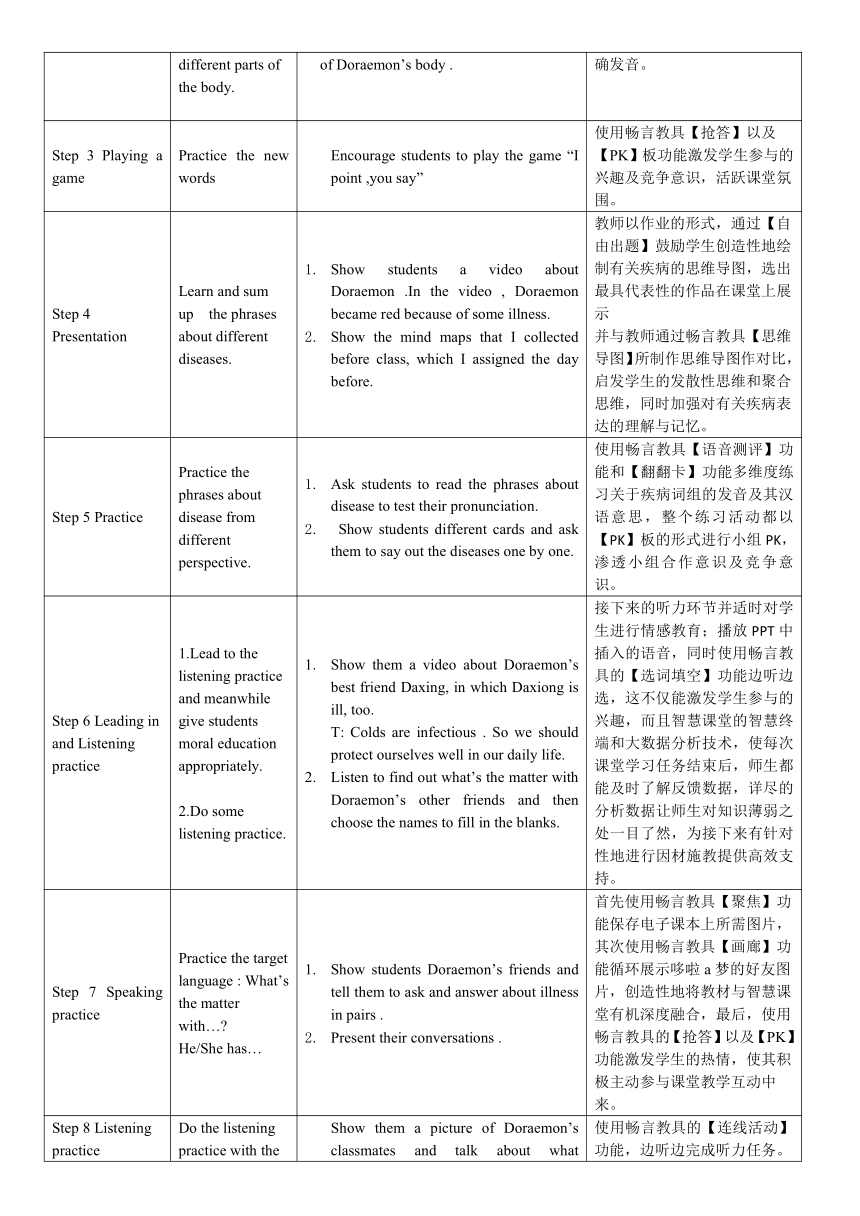Unit 1 What’s the matter Section A 1a-2c 教学设计(表格式)人教版八年级下册
文档属性
| 名称 | Unit 1 What’s the matter Section A 1a-2c 教学设计(表格式)人教版八年级下册 |  | |
| 格式 | docx | ||
| 文件大小 | 79.0KB | ||
| 资源类型 | 教案 | ||
| 版本资源 | 人教新目标(Go for it)版 | ||
| 科目 | 英语 | ||
| 更新时间 | 2024-03-21 19:54:09 | ||
图片预览


文档简介
Unit 1 What’s the matter Section A 1a-2c
教学设计
课题名称: Unit 1 What’s the matter Section A 1a-2c
一、基本信息
教材、学科 人教版新目标英语 章节 第一单元
学时 45分钟 年级 八年级下册
课型 新授课 教具、学具
二、核心素养目标
(1)知识目标: 熟练掌握词汇及短语: throat, foot,neck,stomach,have a cold, have the flu, have a headache, have a fever, have a cough, have a stomachache, have a toothache , have a sore back , have a sore throat, have sore legs ,lie down, take one’s temperature,take some medicine…… 能用以下句型进行交际: What’s the matter with…? I have a stomachache/ have a sore throat/have a fever…. What should I do? You should lie down and rest/ drink some hot tea with honey…. (2)技力目标:结合听说训练的学习活动,掌握身体部位和健康疾患的询问和表示方法,并给出简单意见。 (3)情感态度与价值观:通过本课的学习引导学生关注自己及身边人的身体健康,学习如何关心他人及提出适当的建议并意识到要如何去保持健康并养成良好的生活习惯。
三、学情分析
八年级的学生在这一阶段思想上比较动荡,容易出现两极分化的现象。本班大多数学生的学习态度端正,都能认真完成老师布置的课内外作业,并能积极参与到课堂活动中。但也有少部分学生对英语学习的兴趣不浓,不能积极主动地参与课堂活动,特别是听说部分尤为困难。但随着基于大数据个性化教学与智慧学校项目在我校的顺利实施,智慧课堂的生态体系正在逐步形成。“我们的等待,恰逢花开”,学生们(包括学困生)对此更是兴趣盎然,教师正好抓住该契机最大化地发挥智慧课堂在英语听说课上的优势,将听说课进行了彻头彻尾的改革,不拘泥于传统的条条框框,将“科大讯飞”畅言教具的相关功能与课堂教学活动有机融合,通过不同的任务驱动,在分析问题和解決问题的过程中,促进学生知识的学习、技能的发展、文化内涵的理解、多元思维的形成及解決问题能力的提升。
四、教学重难点
教学重点: 1、疾病的询问和表达。 2、熟练运用should, shouldn’t提出健康建议。 教学难点: 学会谈论健康问题并给出恰当的建议。
五、教学设计
教学环节 环节目标 教学活动(师生活动) 媒体作用及设计意图
Step 1 Warming up and leading in Just warm up and lead to the new lesson Play a video for students to sing along with “The Doraemon song” 播放PPT中插入的英语歌曲,让学生熟悉本节课的主角——多啦a梦。
Step 2 Presentation Learn the new words about different parts of the body. Show students a picture of Doraemon and ask students the names of different parts of Doraemon’s body . 使用畅言教具【英语朗读】功能并生成语音,示范单词的正确发音。
Step 3 Playing a game Practice the new words Encourage students to play the game “I point ,you say” 使用畅言教具【抢答】以及【PK】板功能激发学生参与的兴趣及竞争意识,活跃课堂氛围。
Step 4 Presentation Learn and sum up the phrases about different diseases. Show students a video about Doraemon .In the video , Doraemon became red because of some illness. Show the mind maps that I collected before class, which I assigned the day before. 教师以作业的形式,通过【自由出题】鼓励学生创造性地绘制有关疾病的思维导图,选出最具代表性的作品在课堂上展示 并与教师通过畅言教具【思维导图】所制作思维导图作对比,启发学生的发散性思维和聚合思维,同时加强对有关疾病表达的理解与记忆。
Step 5 Practice Practice the phrases about disease from different perspective. Ask students to read the phrases about disease to test their pronunciation. Show students different cards and ask them to say out the diseases one by one. 使用畅言教具【语音测评】功能和【翻翻卡】功能多维度练习关于疾病词组的发音及其汉语意思,整个练习活动都以【PK】板的形式进行小组PK,渗透小组合作意识及竞争意识。
Step 6 Leading in and Listening practice 1.Lead to the listening practice and meanwhile give students moral education appropriately. 2.Do some listening practice. Show them a video about Doraemon’s best friend Daxing, in which Daxiong is ill, too. T: Colds are infectious . So we should protect ourselves well in our daily life. Listen to find out what’s the matter with Doraemon’s other friends and then choose the names to fill in the blanks. 接下来的听力环节并适时对学生进行情感教育;播放PPT中插入的语音,同时使用畅言教具的【选词填空】功能边听边选,这不仅能激发学生参与的兴趣,而且智慧课堂的智慧终端和大数据分析技术,使每次课堂学习任务结束后,师生都能及时了解反馈数据,详尽的分析数据让师生对知识薄弱之处一目了然,为接下来有针对性地进行因材施教提供高效支持。
Step 7 Speaking practice Practice the target language : What’s the matter with… He/She has… Show students Doraemon’s friends and tell them to ask and answer about illness in pairs . Present their conversations . 首先使用畅言教具【聚焦】功能保存电子课本上所需图片,其次使用畅言教具【画廊】功能循环展示哆啦a梦的好友图片,创造性地将教材与智慧课堂有机深度融合,最后,使用畅言教具的【抢答】以及【PK】功能激发学生的热情,使其积极主动参与课堂教学互动中来。
Step 8 Listening practice Do the listening practice with the target language Show them a picture of Doraemon’s classmates and talk about what problems they have before listening and then tell the students to listen to their talks and draw lines to match the problems and advice. 使用畅言教具的【连线活动】功能,边听边完成听力任务。
Step 9 . Play a game Do the speaking practice with the target language Encourage students to play the game “You mime ,I advise” 使用畅言教具【抢答】以及【PK】功能活跃课堂氛围。
Step 10 . Listening practice and sum up Sum up what we have learnt in this English class.And what’s more, give them some moral education appriately from Doraemon’s perspective. 1. Tell students that Doraemon sent us a voice message and then play the voice message for them to listen to . 2. Ask them questions : Is Doraemon better now What about his friends and classmates What did he say at the end of the message … 使用畅言教具【语音合成】功能合成Doraemon 的语音留言,揭示Doraemon 及其同班同学和好朋友的现状,适时对学生进行情感教育。
Step 11 Homework Consolidate what we have learnt today. 1. Read the words we have learnt on the tablets.( must do it ) 2. Finish the medical record (病例) (choose to do ) 教师以【英语听说专练】布置作业1:教师推送本节课师生互动、生生互动中生成的生词或短语,供基础薄弱的同学大声朗读;教师以【自由出题】的形式布置作业2,供英语能力较强的同学完成。教师要求学生们找到与自身能力相匹配的一项作业或两项作业,鼓励学生们敢于选择颇具挑战性的作业。学生们的作业经过大数据的精准分析后,教师录制微课为学生们答疑解惑,真正做到精准化教学。
六、板书设计
Unit 1 What’s the matter? Section A 1a-2c New Words:neck,stomach, throat New phrases: Key Sentences: ---What’s the matter with him/her? ----He/She has a cough/fever/sore throat…..
七、教学反思
本节课是本单元的第一课时,紧紧围绕疾病的询问和表达以及运用should, shouldn’t提出建议的听说课,教师本着以学生为中心,利用了Doreamon的几个片段贯穿整节课的始末,层次清晰,层层递进,为学生创设一个较真实和轻松愉快的学习、交流的课堂环境,引导学生在情境中学习语言并开展多种类型的听、说任务活动,为学生提供合作交流的空间和时间。 在处理听力时,教师果断舍弃之前的传统方式——边听边完成课文上相应的听力任务。取而代之的是利用畅言备课精灵中的【选词填空】和【连线活动】来设置相应的听力任务,学生提交完之后,就能看到结果,实时高效,同时,通过大数据的精准分析, 在最后课堂总结时,教师也摆脱了传统模式的桎梏,借大胆革新,以Doreamon 的口吻适时对学生进行情感教育,学科育人的目标渗透于无形之中,这也高度契合了“双减”政策下立德树人、全面发展的教育理念。 教师利用智慧课堂的个性化作业功能,进行分层作业布置,分层作业不是根据学生成绩水平高低分组,而是按思维层次性和拓展性设置不同难度的作业,供学生自主弹性选择。 不足之处:本节课的容量较大,有个别学生没有很好的完成预习任务,造成一些语言障碍,再就是词汇教学部分铺设的太多。这需要在以后的教学中不断地反思自我,反思教学,从而实现自我能力的提升。
教学设计
课题名称: Unit 1 What’s the matter Section A 1a-2c
一、基本信息
教材、学科 人教版新目标英语 章节 第一单元
学时 45分钟 年级 八年级下册
课型 新授课 教具、学具
二、核心素养目标
(1)知识目标: 熟练掌握词汇及短语: throat, foot,neck,stomach,have a cold, have the flu, have a headache, have a fever, have a cough, have a stomachache, have a toothache , have a sore back , have a sore throat, have sore legs ,lie down, take one’s temperature,take some medicine…… 能用以下句型进行交际: What’s the matter with…? I have a stomachache/ have a sore throat/have a fever…. What should I do? You should lie down and rest/ drink some hot tea with honey…. (2)技力目标:结合听说训练的学习活动,掌握身体部位和健康疾患的询问和表示方法,并给出简单意见。 (3)情感态度与价值观:通过本课的学习引导学生关注自己及身边人的身体健康,学习如何关心他人及提出适当的建议并意识到要如何去保持健康并养成良好的生活习惯。
三、学情分析
八年级的学生在这一阶段思想上比较动荡,容易出现两极分化的现象。本班大多数学生的学习态度端正,都能认真完成老师布置的课内外作业,并能积极参与到课堂活动中。但也有少部分学生对英语学习的兴趣不浓,不能积极主动地参与课堂活动,特别是听说部分尤为困难。但随着基于大数据个性化教学与智慧学校项目在我校的顺利实施,智慧课堂的生态体系正在逐步形成。“我们的等待,恰逢花开”,学生们(包括学困生)对此更是兴趣盎然,教师正好抓住该契机最大化地发挥智慧课堂在英语听说课上的优势,将听说课进行了彻头彻尾的改革,不拘泥于传统的条条框框,将“科大讯飞”畅言教具的相关功能与课堂教学活动有机融合,通过不同的任务驱动,在分析问题和解決问题的过程中,促进学生知识的学习、技能的发展、文化内涵的理解、多元思维的形成及解決问题能力的提升。
四、教学重难点
教学重点: 1、疾病的询问和表达。 2、熟练运用should, shouldn’t提出健康建议。 教学难点: 学会谈论健康问题并给出恰当的建议。
五、教学设计
教学环节 环节目标 教学活动(师生活动) 媒体作用及设计意图
Step 1 Warming up and leading in Just warm up and lead to the new lesson Play a video for students to sing along with “The Doraemon song” 播放PPT中插入的英语歌曲,让学生熟悉本节课的主角——多啦a梦。
Step 2 Presentation Learn the new words about different parts of the body. Show students a picture of Doraemon and ask students the names of different parts of Doraemon’s body . 使用畅言教具【英语朗读】功能并生成语音,示范单词的正确发音。
Step 3 Playing a game Practice the new words Encourage students to play the game “I point ,you say” 使用畅言教具【抢答】以及【PK】板功能激发学生参与的兴趣及竞争意识,活跃课堂氛围。
Step 4 Presentation Learn and sum up the phrases about different diseases. Show students a video about Doraemon .In the video , Doraemon became red because of some illness. Show the mind maps that I collected before class, which I assigned the day before. 教师以作业的形式,通过【自由出题】鼓励学生创造性地绘制有关疾病的思维导图,选出最具代表性的作品在课堂上展示 并与教师通过畅言教具【思维导图】所制作思维导图作对比,启发学生的发散性思维和聚合思维,同时加强对有关疾病表达的理解与记忆。
Step 5 Practice Practice the phrases about disease from different perspective. Ask students to read the phrases about disease to test their pronunciation. Show students different cards and ask them to say out the diseases one by one. 使用畅言教具【语音测评】功能和【翻翻卡】功能多维度练习关于疾病词组的发音及其汉语意思,整个练习活动都以【PK】板的形式进行小组PK,渗透小组合作意识及竞争意识。
Step 6 Leading in and Listening practice 1.Lead to the listening practice and meanwhile give students moral education appropriately. 2.Do some listening practice. Show them a video about Doraemon’s best friend Daxing, in which Daxiong is ill, too. T: Colds are infectious . So we should protect ourselves well in our daily life. Listen to find out what’s the matter with Doraemon’s other friends and then choose the names to fill in the blanks. 接下来的听力环节并适时对学生进行情感教育;播放PPT中插入的语音,同时使用畅言教具的【选词填空】功能边听边选,这不仅能激发学生参与的兴趣,而且智慧课堂的智慧终端和大数据分析技术,使每次课堂学习任务结束后,师生都能及时了解反馈数据,详尽的分析数据让师生对知识薄弱之处一目了然,为接下来有针对性地进行因材施教提供高效支持。
Step 7 Speaking practice Practice the target language : What’s the matter with… He/She has… Show students Doraemon’s friends and tell them to ask and answer about illness in pairs . Present their conversations . 首先使用畅言教具【聚焦】功能保存电子课本上所需图片,其次使用畅言教具【画廊】功能循环展示哆啦a梦的好友图片,创造性地将教材与智慧课堂有机深度融合,最后,使用畅言教具的【抢答】以及【PK】功能激发学生的热情,使其积极主动参与课堂教学互动中来。
Step 8 Listening practice Do the listening practice with the target language Show them a picture of Doraemon’s classmates and talk about what problems they have before listening and then tell the students to listen to their talks and draw lines to match the problems and advice. 使用畅言教具的【连线活动】功能,边听边完成听力任务。
Step 9 . Play a game Do the speaking practice with the target language Encourage students to play the game “You mime ,I advise” 使用畅言教具【抢答】以及【PK】功能活跃课堂氛围。
Step 10 . Listening practice and sum up Sum up what we have learnt in this English class.And what’s more, give them some moral education appriately from Doraemon’s perspective. 1. Tell students that Doraemon sent us a voice message and then play the voice message for them to listen to . 2. Ask them questions : Is Doraemon better now What about his friends and classmates What did he say at the end of the message … 使用畅言教具【语音合成】功能合成Doraemon 的语音留言,揭示Doraemon 及其同班同学和好朋友的现状,适时对学生进行情感教育。
Step 11 Homework Consolidate what we have learnt today. 1. Read the words we have learnt on the tablets.( must do it ) 2. Finish the medical record (病例) (choose to do ) 教师以【英语听说专练】布置作业1:教师推送本节课师生互动、生生互动中生成的生词或短语,供基础薄弱的同学大声朗读;教师以【自由出题】的形式布置作业2,供英语能力较强的同学完成。教师要求学生们找到与自身能力相匹配的一项作业或两项作业,鼓励学生们敢于选择颇具挑战性的作业。学生们的作业经过大数据的精准分析后,教师录制微课为学生们答疑解惑,真正做到精准化教学。
六、板书设计
Unit 1 What’s the matter? Section A 1a-2c New Words:neck,stomach, throat New phrases: Key Sentences: ---What’s the matter with him/her? ----He/She has a cough/fever/sore throat…..
七、教学反思
本节课是本单元的第一课时,紧紧围绕疾病的询问和表达以及运用should, shouldn’t提出建议的听说课,教师本着以学生为中心,利用了Doreamon的几个片段贯穿整节课的始末,层次清晰,层层递进,为学生创设一个较真实和轻松愉快的学习、交流的课堂环境,引导学生在情境中学习语言并开展多种类型的听、说任务活动,为学生提供合作交流的空间和时间。 在处理听力时,教师果断舍弃之前的传统方式——边听边完成课文上相应的听力任务。取而代之的是利用畅言备课精灵中的【选词填空】和【连线活动】来设置相应的听力任务,学生提交完之后,就能看到结果,实时高效,同时,通过大数据的精准分析, 在最后课堂总结时,教师也摆脱了传统模式的桎梏,借大胆革新,以Doreamon 的口吻适时对学生进行情感教育,学科育人的目标渗透于无形之中,这也高度契合了“双减”政策下立德树人、全面发展的教育理念。 教师利用智慧课堂的个性化作业功能,进行分层作业布置,分层作业不是根据学生成绩水平高低分组,而是按思维层次性和拓展性设置不同难度的作业,供学生自主弹性选择。 不足之处:本节课的容量较大,有个别学生没有很好的完成预习任务,造成一些语言障碍,再就是词汇教学部分铺设的太多。这需要在以后的教学中不断地反思自我,反思教学,从而实现自我能力的提升。
同课章节目录
- Unit 1 What's the matter?
- Section A
- Section B
- Unit 2 I'll help to clean up the city parks.
- Section A
- Section B
- Unit 3 Could you please clean your room?
- Section A
- Section B
- Unit 4 Why don't you talk to your parents?
- Section A
- Section B
- Unit 5 What were you doing when the rainstorm came
- Section A
- Section B
- Review of Units 1-5
- Unit 6 An old man tried to move the mountains.
- Section A
- Section B
- Unit 7 What's the highest mountain in the world?
- Section A
- Section B
- Unit 8 Have you read Treasure Island yet?
- Section A
- Section B
- Unit 9 Have you ever been to a museum?
- Section A
- Section B
- Unit 10 I've had this bike for three years.
- Section A
- Section B
